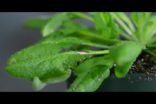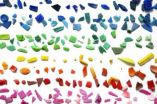(Press-News.org) The light-warping structures known as metamaterials have a new trick in their ever-expanding repertoire. Researchers at the National Institute of Standards and Technology (NIST) have built a silver, glass and chromium nanostructure that can all but stop visible light cold in one direction while giving it a pass in the other.* The device could someday play a role in optical information processing and in novel biosensing devices.
In recent years, scientists have designed nanostructured materials that allow microwave or infrared light to propagate in only one direction. Such structures hold potential for applications in optical communication—for instance, they could be integrated into photonic chips that split or combine signals carried by light waves. But, until now, no one had achieved one-way transmission of visible light, because existing devices could not be fabricated at scales small enough to manipulate visible light's short wavelengths. (So-called "one-way mirrors" don't really do this—they play tricks with relative light levels.)
To get around that roadblock, NIST researchers Ting Xu and Henri Lezec combined two light-manipulating nanostructures: a multi-layered block of alternating silver and glass sheets and metal grates with very narrow spacings.
The silver-glass structure is an example of a "hyperbolic" metamaterial, which treats light differently depending on which direction the waves are traveling. Because the structure's layers are only tens of nanometers thick—much thinner than visible light's 400 to 700 nanometer wavelengths—the block is opaque to visible light coming in from outside. Light can, however, propagate inside the material within a narrow range of angles.
Xu and Lezec used thin-film deposition techniques at the NIST NanoFab user facility to build a hyperbolic metamaterial block.Guided by computer simulations, they fabricated the block out of 20 extremely thin alternating layers of silicon dioxide glass and silver. To coax external light into the layered material, the researchers added to the block a set of chromium grates with narrow, sub-wavelength spacings chosen to bend incoming red or green light waves just enough to propagate inside the block. On the other side of the block, the researchers added another set of grates to kick light back out of the structure, although angled away from its original direction.
While the second set of grates let light escape the material, their spacing was slightly different from that of the first grates. As a result, the reverse-direction grates bent incoming light either too much or not enough to propagate inside the silver-glass layers. Testing their structures, the researchers found that around 30 times more light passed through in the forward direction than in reverse, a contrast larger than any other achieved thus far with visible light.
Combining materials that could be made using existing methods was the key to achieving one-way transmission of visible light, Lezec says. Without the intervening silver-and-glass blocks, the grates would have needed to be fabricated and aligned more precisely than is possible with current techniques. "This three-step process actually relaxes the fabrication constraints," Lezec says.
In the future, the new structure could be integrated into photonic chips that process information with light instead of electricity. Lezec thinks the device also could be used to detect tiny particles for biosensing applications. Like the chrome grates, nanoscale particles also can deflect light to angles steep enough to travel through the hyperbolic material and come out the other side, where the light would be collected by a detector. Xu has run simulations suggesting such a scheme could provide high-contrast particle detection and is hoping to test the idea soon. "I think it's a cool device where you would be able to sense the presence of a very small particle on the surface through a dramatic change in light transmission," says Lezec.
INFORMATION:
*T. Xu and H.J. Lezec. Visible-frequency asymmetric transmission devices incorporating a hyperbolic metamaterial. Nature Communications. 2014, 5, DOI: 10.1038/ncomms5141. http://www.nature.com/ncomms/2014/140617/ncomms5141/full/ncomms5141.html
New NIST metamaterial gives light a one-way ticket
2014-07-01
ELSE PRESS RELEASES FROM THIS DATE:
Fear, not data, motivates sunscreen users, research shows
2014-07-01
BUFFALO, N.Y. – We're often told that worrying can be harmful to one's health. But University at Buffalo researchers say that when it comes to preventing skin cancer, a little fear is good for you.
In a study published in the Journal of Behavioral Medicine, the UB researchers found that fear and worry about skin cancer had a bigger influence on people's use of sunscreen than information about the statistical likelihood of developing the disease.
"Most health behavior studies don't account for the more visceral, emotional reactions that lead people to do risky behaviors, ...
NIST test house exceeds goal; ends year with energy to spare
2014-07-01
The net-zero energy test house at the National Institute of Standards and Technology (NIST) in suburban Washington, D.C., not only absorbed winter's best shot, it came out on top, reaching its one-year anniversary on July 1 with enough surplus energy to power an electric car for about 1,440 miles.*
Watch the YouTube video at https://www.youtube.com/watch?v=iJZrOhPk4kg
Despite five months of below-average temperatures and twice the normal amount of snowfall, NIST's Net-Zero Energy Residential Test Facility (NZERTF) ended its one-year test run with 491 kilowatt hours ...
Biomarker predicts effectiveness of brain cancer treatment
2014-07-01
Researchers at the University of California, San Diego School of Medicine have identified a new biomarker that predicts whether glioblastoma – the most common form of primary brain cancer – will respond to chemotherapy. The findings are published in the July print issue of Oncotarget.
"Every patient diagnosed with glioblastoma is treated with a chemotherapy called temozolomide. About 15 percent of these patients derive long-lasting benefit," said Clark C. Chen, MD, PhD, vice-chairman of Academic Affairs, Division of Neurosurgery, UC San Diego School of Medicine and the ...
Plants respond to leaf vibrations caused by insects' chewing, MU study finds
2014-07-01
VIDEO:
Experiments by Heidi Appel and Rex Cocroft at the University of Missouri mark the first time scientists have shown that a plant responds to an ecologically relevant sound in its...
Click here for more information.
COLUMBIA, Mo. – Previous studies have suggested that plant growth can be influenced by sound and that plants respond to wind and touch. Now, researchers at the University of Missouri, in a collaboration that brings together audio and chemical analysis, have ...
Reigning in chaos in particle colliders yields big results
2014-07-01
WASHINGTON D.C., June 30, 2014 – When beams with trillions of particles go zipping around at near light speed, there's bound to be some chaos. Limiting that chaos in particle colliders is crucial for the groundbreaking results such experiments are designed to deliver.
In a special focus issue of the journal Chaos, from AIP Publishing, a physicist at the European Organization for Nuclear Research (CERN) details an important method of detecting and correcting unwanted chaotic behavior in particle colliders. The method is helping accelerator physicists design high-performing, ...
Research reveals a gender gap in the nation's biology labs
2014-07-01
CAMBRIDGE, MA -- Among the sciences, biology consistently attracts the greatest numbers of women to graduate school and academic careers. About half of all biology graduate students are women, and 40 percent of biology postdocs are female. However, those numbers drop dramatically among faculty members: Nationwide, only 36 percent of assistant professors and 18 percent of full professors are women.
A new study reveals a possible explanation for this discrepancy: In the labs of the highest-achieving male biology professors — winners of the Nobel Prize, the National Medal ...
Study reveals that many people are oblivious to how they come across to counterparts and colleagues
2014-07-01
NEW YORK—Jill Abramson was recently ousted from her position as the executive editor of The New York Times for being, among other things, too "pushy." But did Abramson—who has also been described by the media as "polarizing" and "brusque"—know during the course of her tenure that others viewed her as being overly assertive? A new study from the Columbia Business School suggests that there's a great chance she didn't.
"Finding the middle ground between being pushy and being a pushover is a basic challenge in social life and the workplace. We've now found that the challenge ...
All the world's oceans have plastic debris on their surface
2014-07-01
However, central surface waters of the oceans may not be the final destination of plastic debris since, as indicated by the study performed by the Malaspina Expedition, large amounts of microplastics could be passing to the marine food chain and the ocean floor. Results of the study, led by the University of Cadiz (Spain), have been published in the journal Proceedings of the National Academy of Sciences (PNAS).
Andrés Cózar, researcher from the University of Cadiz, explains: "Ocean currents carry plastic objects which split into smaller and smaller fragments due to solar ...
Genetic evidence that body mass increases the risk of asthma in mid-childhood
2014-07-01
Some of the increase in asthma risk toward the end of the 20th century could be attributed to the increase in body mass index (BMI) in mid-childhood, according to new research published in this week's PLOS Medicine. The study, led by Raquel Granell from the University of Bristol, UK, and colleagues, provides genetic evidence that higher fat mass and lean mass increase the risk of asthma in mid-childhood.
The incidence of asthma, a chronic condition caused by inflammation of the airways, has been rising steadily over the past few decades, and it is estimated that 200� ...
Cesarean section linked to slight increase in future stillbirth and ectopic pregnancy
2014-07-01
Caesarean section is associated with a slightly increased rate of subsequent stillbirth and ectopic pregnancy, according to a large study of women living in Demark, published in this week in PLOS Medicine. Given the global increase in Caesarean rates, the results of the study, which was conducted by Louise Kenny and colleagues from University College Cork, Ireland and Aarhus University, Denmark, are of interest to pregnant women, their partners, and healthcare providers.
The researchers obtained data for 832,996 women from Danish national registers regarding their first ...





